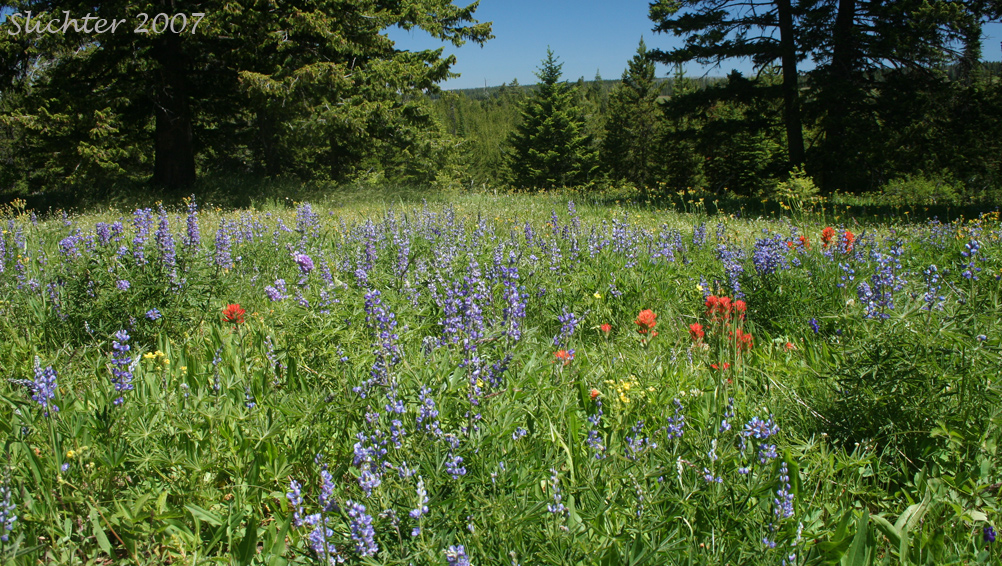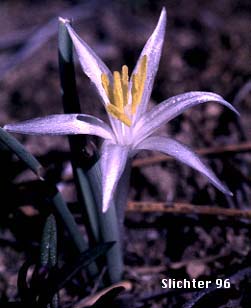
[Wildflowers East of the Cascade Mountains of Oregon and Washington]
 Wildflower Books:
Wildflower Books:
1. Sagebrush Country: A Wildflower Sanctuary
By Ronald J. Taylor, Copyright 1992 by the Mountain Press Publishing Company (2016 Strand Avenue, P.O. Box 2399, Missoula, MT 59801). ISBN 0-87842-280-3
This is a nice softbound book covering the vegetation and life zones of the Columbia and Great Basins. Plants from outside the Pacific Northwest are covered. The photographs are large, in color, and are useful for helping identify plants. Several paragraphs of description accompany each plant species.
2. Intermountain Flora: Vascular Plants of the Intermountain West, U.S.A..
By Arthur Cronquist, ARthur H. Holmgren, Noel H. Homgren, James L. Reveal, and Patricia K. Holmgren, Copyright 1994 by the New York Botanical Garden. ISBN 0-89327-375-9
This is a complete series of 5 volumes dealing with the vegetation of the basin country of the intermountain west, covering in detail the species of southeast Oregon, southern Idaho, and the bulk of Nevada and Utah. Although this series is quite spendy in price, the descriptions, illustrations, and keys make them books well worth buying if you are serious about plants of the Great Basin.
3. Flora of the Pacific Northwest
By C. Leo Hitchcock and Arthur Cronquist, Copyright 1972 by the University of Washington Press. ISBN 0-295-95273-3
This is the bible of Pacific Northwest Plants, covering the wildflowers, grasses, trees and shrubs of most of the region. It is nicely illustrated with small drawings of most of the thousands of plants identified. However, it would best be used by those familiar with using complex classification keys. It is also available in a 5 volume, large format set, which has enlarged illustrations and more information regarding identifying characteristics, but the price for each volume is spendy! I use the 5 volume set wherever possible because of these fine drawings and descriptive entries.
4. Weeds of Eastern Washington
By Xerpha M. Gaines and D.G. Swan, Copyright 1972 by Camp-Na-Bor-Lee Association, Inc- Davenport, Washington 99122.
This book is out of print, to my knowledge, but might still be available. It covers eastern Washington and would be representative of other parts of the Columbia Basin. It contains some nice color artwork of each "weed" as well as a short description of each plant. It might be interesting to use this book to compare how the weeds of this region have changed since 1972.
5. Flora of Southeastern Washington
By Harold St. John, Copyright 1937 (revised edition 1956) by the Students Book Corporation, Pullman, WA.
This book is long out of print, but I often see used copies available at several bookstores. It covers southeastern Washington, from Spokane southward, and westward to the Columbia River. It also deals with plants as far south as the Blue Mts of Oregon, and the western edge of the Idaho panhandle between Coeur d'Alene and Lewiston. There are no flower illustrations, but each species is described in a paragraph. The scientific names may sometimes be out of date. A classification key for identification of families is provided.
6. Sagebrush Wildflowers
By J.E. (Ted) Underhill, Copyright 1986 by Hancock House Publishers LTD (19313 Zero Ave., Surrey, B.C. V3S 5J9. ISBN 0-88839-171-4
This is a thin paperback book covering sagebrush communities of British Columbia, Washington, Idaho, and northern Oregon. It is an introductory book, with nice color photos, description of each species, but lacks specific species names in some cases for the plants shown. I'm not sure if it is still in print, but I occasionally see it at stores. It covers about 50 species of common sagebrush community plants.
7. Guide to the Plants of the Wallowa Mountains of Northeastern Oregon
By Georgia Mason, Copyright 1975 by the University of Oregon Press, Eugene, OR.
This paperback is pretty inclusive for this region of northeastern Oregon, but is out of print. I occasionally see a copy at bookstores that sell used books. Each genus has a key, each species is described in paragraph form, and there are many small black and white line drawings, which are somewhat useful. This is definitely a book to use for those who like to explore this unique area.
8. The Jepson Manual: Higher Plants of California
Edited By James C. Hickman, Copyright 1993 by the University of California Press, Berkeley and Los Angeles, California. ISBN 0-520-08255-9
This 1400 page volume is especially useful for covering the plants of south central and southeastern Oregon, where Hitchcock is incomplete. This volume also contains the latest scientific name changes, which are fairly numerous, and makes botanizing the southern perimeter of Oregon interesting, as it can sometimes be challenging comparing the names to those listed in the Hitchcock and Cronquist volumes listed above. The families are listed alphabetically, and small black and white drawings accompany the brief paragraphs of each species.
9. Northwest Penstemons
By Dee Strickler, Copyright 1997. Published by Flower Press, Columbia Falls, Montana. ISBN 1-56044-572-6.
If you like Penstemons, then you know they're hard to identify. This is a very helpful book, beautifully illustrated with numerous large, color photos, a number of line drawings of key identifying features, and range maps (some of which may be slightly inaccurate). There is also a comprehensive key, which can help get you down not only to the species, but also the variety in many cases. This book has helped me make sense of this beautiful genus of flowers.
10. BLM/ Washington- Watchable Flowers: A Columbia Basin Guide
Put together by the Bureau of Land Management and released early in 1998, this is a superb resource for anyone wanting to visit fairly natural sites in the Columbia Basin of Washington. The color photos are numerous and superb, there are short descriptions of a number of the more common wildflowers, along with a brief geological history of the region and a description of the major habitats. Ten BLM wildflower sites are described, complete with maps and written descriptions of how to get there, and again, lots of photos. A brochure is also included for each site, listing common name and species name for the plants found there, including a blooming schedule. At $8.00, it's a bargain. I've visited several sites, and saw a number of people using this guide to help them identify plants. Your best bet would be to obtain this booklet from one of the BLM offices in Washington state.